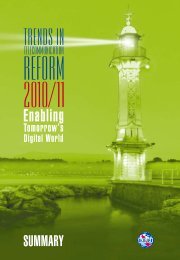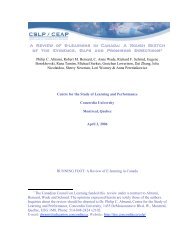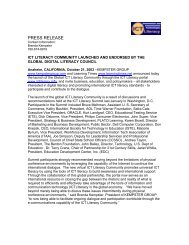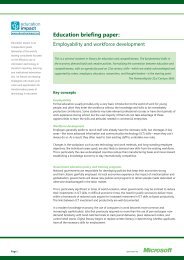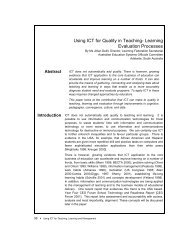147 pages pdf - ICT Digital Literacy
147 pages pdf - ICT Digital Literacy
147 pages pdf - ICT Digital Literacy
Create successful ePaper yourself
Turn your PDF publications into a flip-book with our unique Google optimized e-Paper software.
Pedagogy & Webagogy -- Ready, Set … TRAIN and FACILITATE!<br />
#513: Out of Sight, Out of Mind<br />
I recommend a web-cam on your delivery side so students can at least see you from time to<br />
time and remember that you are real.<br />
Howard Goldstein<br />
Howard Goldstein Associates<br />
#514: Lurk Before Jumping In<br />
Encourage the interaction and problem solving skills of students by "lurking" before jumping in with a<br />
response. Be aware of your "timing." Try to encourage the group to come up with some solutions first,<br />
although you may need to re-focus contributions if the discussion goes completely off track.<br />
Frankie Forsyth<br />
Australian Flexible Learning Community<br />
#515: "Office" Hours<br />
Set aside a block of time each day to respond to learner questions and concerns. Inform the<br />
students about these times.<br />
George Drops<br />
National University<br />
#516: From Contact To Community<br />
Try to make contact with the participants early and often. Start with emails giving them instructions for contacting you<br />
and a reason to do so. For example: "Please confirm that this is the email address we should use to contact you.",<br />
"Please let us know what your technology level is—equipment and personal expertise.", "Please let us know what<br />
you hope to gain from this course." etc. If possible, arrange a conference call before the start of the course to address<br />
all the questions participants may have and to help them connect with each other. Use calls, discussion boards and<br />
live chats to keep them connected and active. Once contact is made, help the participants to build community.<br />
Grouping them may work. Asking them to build home<strong>pages</strong> and/or post introductory messages on the discussion<br />
board may work. Asking them to choose an avatar to represent themselves, and then explain their choice is a good<br />
option, especially for those who don’t want to post pictures of themselves on the web.<br />
Holly Garrett<br />
Cogeco<br />
#517: e-Teach To e-Learn<br />
Always try to get the e-Learner to be an e-Teacher. Get them to engage in discussion with<br />
other e-Learners about the topic, particularly if they can provide material or insight into their<br />
better understanding of the new discipline.<br />
Peter Duffey<br />
Groove Networks<br />
#518: Same As It Ever Was<br />
Prepare the learner for e-Learning by offering both online and face-to-face orientations to the CMS/LMS. Make<br />
students/participants aware of instructor availability at the very beginning of the course. Then be consistent in the<br />
delivery of responses, information, assignments, etc. by using the same format throughout the course. Write for the<br />
web - do not write in prose - students will not read it. Use bullet points, subheadings, etc. that can be easily scanned<br />
for information. And be flexible as an instructor - know how fickle technology can be and be fair to your students.<br />
Nanette Stillwell<br />
Pitt Community College<br />
#519: Getting The Right Answer Doesn't Mean You Understand It<br />
Employ "live" math to assist student comprehension.<br />
Lynn Brown<br />
Web Pearls, Inc<br />
701 e-Learning Tips by The MASIE Center www.masie.com 103






